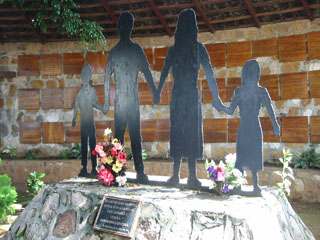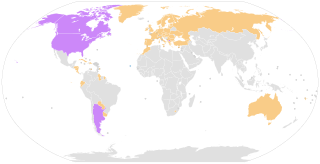Related Research Articles
International human rights instruments are the treaties and other international texts that serve as legal sources for international human rights law and the protection of human rights in general. There are many varying types, but most can be classified into two broad categories: declarations, adopted by bodies such as the United Nations General Assembly, which are by nature declaratory, so not legally-binding although they may be politically authoritative and very well-respected soft law;, and often express guiding principles; and conventions that are multi-party treaties that are designed to become legally binding, usually include prescriptive and very specific language, and usually are concluded by a long procedure that frequently requires ratification by each states' legislature. Lesser known are some "recommendations" which are similar to conventions in being multilaterally agreed, yet cannot be ratified, and serve to set common standards. There may also be administrative guidelines that are agreed multilaterally by states, as well as the statutes of tribunals or other institutions. A specific prescription or principle from any of these various international instruments can, over time, attain the status of customary international law whether it is specifically accepted by a state or not, just because it is well-recognized and followed over a sufficiently long time.
The Convention on the Prevention and Punishment of the Crime of Genocide was unanimously adopted by the United Nations General Assembly on 9 December 1948 as General Assembly Resolution 260. The Convention entered into force on 12 January 1951. It defines genocide in legal terms, and is the culmination of years of campaigning by lawyer Raphael Lemkin. All participating countries are advised to prevent and punish actions of genocide in war and in peacetime. As of May 2019, 152 states have ratified or acceded to the treaty, most recently Mauritius on 8 July 2019. One state, the Dominican Republic, has signed but not ratified the treaty.
International human rights law (IHRL) is the body of international law designed to promote human rights on social, regional, and domestic levels. As a form of international law, international human rights law are primarily made up of treaties, agreements between sovereign states intended to have binding legal effect between the parties that have agreed to them; and customary international law. Other international human rights instruments, while not legally binding, contribute to the implementation, understanding and development of international human rights law and have been recognized as a source of political obligation.

The American Convention on Human Rights, also known as the Pact of San José, is an international human rights instrument. It was adopted by many countries in the Western Hemisphere in San José, Costa Rica, on 22 November 1969. It came into force after the eleventh instrument of ratification was deposited on 18 July 1978.
International adoption is a type of adoption in which an individual or couple becomes the legal and permanent parent(s) of a child who is a national of a different country. In general, prospective adoptive parents must meet the legal adoption requirements of their country of residence and those of the country whose nationality the child holds.

The Hague Convention on the Civil Aspects of International Child Abduction or Hague Abduction Convention is a multilateral treaty developed by the Hague Conference on Private International Law (HCCH) that provides an expeditious method to return a child internationally abducted by a parent from one member country to another.

The Hague Convention on parental responsibility and protection of children, or Hague Convention 1996, officially Convention of 19 October 1996 on Jurisdiction, Applicable Law, Recognition, Enforcement and Co-operation in respect of Parental Responsibility and Measures for the Protection of Children or Hague Convention 1996 is a convention of the Hague Conference on Private International Law. It covers civil measures of protection concerning children, ranging from orders concerning parental responsibility and contact to public measures of protection or care, and from matters of representation to the protection of children's property. It is therefore much broader in scope than two earlier conventions of the HCCH on the subject.
An unaccompanied minor is a child without the presence of a legal guardian.

International child abduction in Japan refers to the illegal international abduction or removal of children from their country of habitual residence by an acquaintance or family member to Japan or their retention in Japan in contravention to the law of another country. Most cases involve a Japanese mother taking her children to Japan in defiance of visitation or joint custody orders issued by Western courts. The issue is a growing problem as the number of international marriages increases. Barring exceptional circumstances, the effects of child abduction are generally detrimental to the welfare of children. Parental abduction often has a particularly devastating effect on parents who may never see their children again.

The Hague Convention on Protection of Children and Co-operation in Respect of Intercountry Adoption is an international convention dealing with international adoption, child laundering, and child trafficking in an effort to protect those involved from the corruption, abuses, and exploitation which sometimes accompanies international adoption. The Convention has been considered crucial because it provides a formal international and intergovernmental recognition of intercountry adoption to ensure that adoptions under the Convention will generally be recognized and given effect in other party countries.

Mexico is amongst the world's most popular sources and destinations for international child abduction while also being widely regarded as having one of the least effective systems of protecting and returning internationally abducted children within its borders.
The term international child abduction is generally synonymous with international parental kidnapping,child snatching, and child stealing. However, the more precise legal usage of international child abduction originates in private international law and refers to the illegal removal of children from their home by an acquaintance or family member to a foreign country. In this context, "illegal" is normally taken to mean "in breach of custodial rights" and "home" is defined as the child's habitual residence. As implied by the "breach of custodial rights," the phenomenon of international child abduction generally involves an illegal removal that creates a jurisdictional conflict of laws whereby multiple authorities and jurisdictions could conceivably arrive at seemingly reasonable and conflicting custodial decisions with geographically limited application. Such a result often strongly affects a child's access and connection to half their family and may cause the loss of their former language, culture, name and nationality, it violates numerous children's rights, and can cause severe psychological and emotional trauma to the child and family left behind.
The Inter-American Convention on the International Return of Children is a treaty of the Organization of American States and was adopted at Montevideo, Uruguay on July, 15 1989 at the Fourth Inter-American Specialized Conference On Private International Law. Its entry into force was November 4, 1994.

International child abduction in Brazil comprises cases in which the removal of a child by one of the joint holders of custody or non-custodial or contested parents to Brazil in contravention of other laws of other countries and/or the desires of other custody claimants. The phenomenon of international child abduction is defined in international law and legislated on by the Hague Convention on the Civil Aspects of International Child Abduction, which entered into force in Brazil on January 1, 2000 and aims to trace abducted children, secure their prompt return to the country of habitual residence and organize or secure effective rights of access. In 2010 Brazil was accused by the US State Department of being non-compliant with the Hague Convention.
Abbott v. Abbott, 560 U.S. 1 (2010), was a decision by the Supreme Court of the United States holding that a parent's ne exeat right is a "right to custody" under the Hague Convention on the Civil Aspects of International Child Abduction and the US International Child Abduction Remedies Act. The child thus should have been returned to Chile, the country of "habitual residence" because the mother violated the ne exeat right of the father when taking the child to the United States without the father's consent.

As a result of its high level of immigration and emigration and its status as common source and destination for a large amount of international travel the United States has more incoming and outgoing international child abductions per year than any other country. To address this issue the United States played an active role in the drafting of the 1980 Hague Convention on the Civil Aspects of International Child Abduction Although the United States was one of the first nations to sign the Convention in 1981 the Convention did not enter into force for the US until 1988 with the enactment by Congress of the International Child Abduction Remedies Act which translated the Convention into US law.
The Children's Act, 2005 is an act of the Parliament of South Africa that consolidates and reforms the law on matters related to children. It deals with topics including the age of majority, paternity, custody, child support, guardianship, parenting plans, children's courts, circumcision, day care, child protection, foster care, group homes, adoption, surrogacy, child abduction, and trafficking of children.
The Federated States of Micronesia is a United States Associated State consisting of 4 states across the Western Pacific Ocean. The estimated population in 2015 was 105,216. Formerly the FSM was a part of the Trust Territory of the Pacific Islands (TTPI) but in 1979 formed its own constitutional government. FSM has a written constitution which took effect in 1979 and has been amended only once in 1990. By virtue of membership in the United Nations, the FSM abides by the UN Declaration of Human Rights (UDHR). Key human rights concerns in FSM include judicial delays, government corruption, discrimination against women, domestic violence and child neglect.
References
- ↑ "International Treaties: Inter-American Convention on International Traffic in Minors" . Retrieved 29 April 2012.
- ↑ "Inter-American Convention on International Traffic in Minors" . Retrieved 29 April 2012.
- ↑ "Inter-American Convention Section". HCCH. Archived from the original on 2012-03-06. Retrieved 2012-04-23.